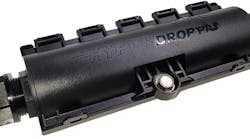There's so much to see at ASIS, which is why this show draws people from around the world. Earlier, on a break from putting together our ASIS eNewsletter for you, I met security directors based out of Venezuela and Mexico -- this truly is ASIS International.
People from around the world know that they need to come to ASIS to find the latest technology, and of course, the big word from so many of the top manufacturers, like JVC and Axis Communications to name a couple, has been the IP-addressable/network-based systems that are being developed.
My associate Steve Lasky, editor and publisher with Security Technology & Design, has been focusing a regular part of the content in his magazine on the issue of convergence in the last couple years, and I have to say that his confidence in the "coming now" nature of IP-based surveillance systems was really ringing true when I went to walk the ASIS floor on Tuesday.
Stopping by the previously mentioned Axis Communications booth (#1229), I talked with general manager Fredrik Nilsson to get a clearer picture of what the trend toward IP cameras meant. The first thing that Nilsson impressed upon me was that these IP-addressable cameras are anything but the old video chat web cams of the past. Not only do they offer the physical features that the industry has come to expect in terms of pan, tilt and zoom, plus a solid construction format (and good dome designs that every facility needs), but the neat thing about these cameras is that the models from his company, like others in the industry, offer the video compression directly in the camera, which helps them from eating up bandwidth that would otherwise choke a cable and still have to be compressed at the video-storage location.
But Ethernet-based cameras aren't manna from heaven, yet, says Nilsson, who, while being one of the biggest fans of Ethernet connected cameras, still recognizes the limitations. Ethernet, as fast as it is when you're using it to connect your computer to the web, has very definite limits on the amount of video data that can be sent, especially if you're working in a 30fps mode. So the idea that you can just walk over to the IT department and tell them that you'll be borrowing their bandwidth to monitor a set of hallways with a half-dozen cameras is going to fly like lead balloon. But on the flipside, he spoke about the ability to buy non-proprietary switches and data storage devices ("The DVR may well be the world's most expensive PC," he notes), and about the greater willingness to converge that the IT staff will have when they see that the hardware pushing a security system is the same type of hardware that they're already familiar with.
Does it mean that IT-network based camera systems are about to be the dominant force in the security surveillance industry? Certainly not, he says, admitting that traditional camera systems still have very real applications that IP network systems have yet to compete with. "Network camera technology has to continue to be humble," he notes, pointing to the fact that companies like Axis and others offering this "converged" technology aren't looking to make enemies, but instead are trying to create alliances so that the entire industry can truly converge and unite.
Of course, if booth giveaways of Ethernet cables and related promotional brochures are any indication, IP-based surveillance is the mark of the future, especially if the price continues to drop and more features are added. Our advice: If you haven't taken the time to look at this technology for whatever reason -- unfamiliarity, cost or from misunderstandings of what this is -- please check in with your preferred vendors and get a feel for what's available. I'm sure it will grab your attention, even if you're years away from adopting this technology.
Editor's note: Look fore more information on the topics of IP network surveillance and convergence at SecurityInfoWatch.com and in our sister publications Security Technology & Design and Security Dealer magazines.

